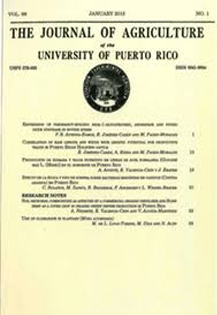Abstract
In Puerto Rico, the most commonly planted citrus crops are oranges, mandarins and limes. Farmers still have an interest in citrus production despite the detrimental effect of the Huanglongbing (HLB) disease on island orchards. Vector control and use of slow-release fertilizers (SRF) and soluble fertilizer (SF) applications to the soil are among the recommended management practices to increase citrus production. In 2009, the Department of Agriculture of Puerto Rico (DAPR) appointed the fruit tree specialist from the University of Puerto Rico and a DAPR staff member to evaluate the condition of citrus production in Puerto Rico. Based on that evaluation, DAPR developed an initiative to increase the number of marketable fruits of oranges, mandarins, and limes from trees between five and 12 years of age by promoting the use of SRF in combination with SF applications to the soil. An experiment was established during 2011 in a seven-year-old ‘Tahiti’ lime orchard in Ciales, Puerto Rico, to compare fertilization methods promoted by the DAPR with conventional methods, estimating the profitability of each method. The DAPR fertilizer recommendations were developed specifically for situations where HBL is present. In the orchards under study, HBL was not observed and therefore not tested. This does not mean that trees were not infected because symptoms may take months or years to become visible. The fertilization methods evaluated were: (1) granular fertilizers applied every four months (conventional fertilization), (2) manual application of SRF twice a year plus the application of SF to the soil with a backpack sprayer four times a year (SRF+SF/backpack), (3) manual application of SRF twice a year plus the application of SF to the soil with a motorized sprayer four times a year (SRF+SF/motorized), and (4) manual application of SRF twice a year. Total fruit number, total fruit weight, and average fruit weight were measured. Harvests were carried out monthly for 15 months. In the first seven harvests, the performance of trees submitted to the combination of SRF and SF was more efficient than was conventional fertilization or SRF alone, since the same production was maintained using a considerably lower amount of nutrients. At 14 months, the application twice a year of SRF alone almost doubled yield although the effect of this treatment was inconsistent during the year. We estimate that the combination of SRF and SF applications to the soil will result in the highest profitability with an income of $27 per tree per year and a profitability of $8.05 per dollar spent.

